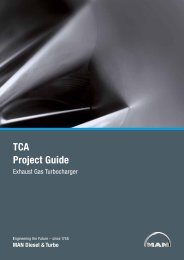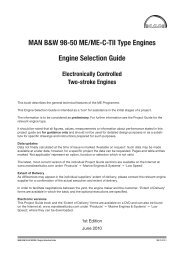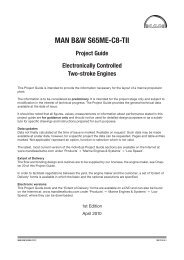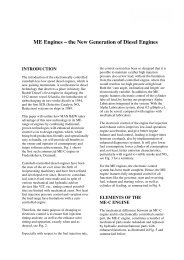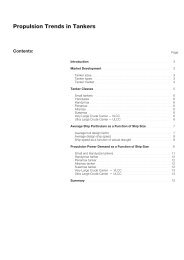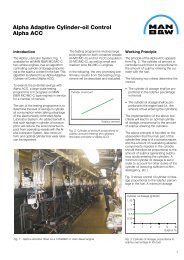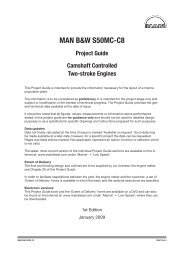Image Study Diesel Power Plants - MAN Diesel & Turbo
Image Study Diesel Power Plants - MAN Diesel & Turbo
Image Study Diesel Power Plants - MAN Diesel & Turbo
Create successful ePaper yourself
Turn your PDF publications into a flip-book with our unique Google optimized e-Paper software.
<strong>Image</strong> <strong>Study</strong><br />
Combined Cycle<br />
While operating <strong>Diesel</strong> or gas engines, a<br />
considerable amount of heat from engine<br />
cooling and hot exhaust gases is produced.<br />
Rather than releasing that heat into the<br />
environment, it is an option to direct it into a<br />
heat-recovery system like a steam boiler where<br />
it is used to drive a steam turbine that creates<br />
additional electrical energy. That process is<br />
called combined cycle and the expression is<br />
based on the fact that the single cycle of an<br />
internal combustion engine (e.g. <strong>Diesel</strong> cycle)<br />
or gas turbine (Joule/Brayton cycle) is now<br />
combined with a steam turbine (Rankine cycle).<br />
A combined cycle considerably improves the<br />
performance of a power plant. In a <strong>Diesel</strong><br />
combined cycle (engine plus steam turbine),<br />
the electrical power output can be raised by<br />
10% without any additional fuel oil<br />
consumption. As a result, the plant’s total<br />
output increases accordingly. Gas turbine<br />
combined cycles show even higher numbers<br />
when it comes to thermal efficiency and<br />
electrical output.<br />
Combined Heat and <strong>Power</strong><br />
A combined heat and power (CHP) or co-<br />
generation plant also makes use of the waste<br />
heat from engine cooling that is created. But<br />
rather than using it to generate additional<br />
electrical energy, the heat can be used for a<br />
district heating or cooling network, municipal<br />
facilities, or industrial processes at local<br />
companies. Combining a power plant’s<br />
electrical and heat efficiency in such a way, it<br />
is possible for the plant’s total efficiency to<br />
come close to 90%. When considering the high<br />
efficiency and the range of different uses for<br />
the combination of heat and electricity, cities<br />
and communities, independent investors as<br />
well as industrial companies could benefit<br />
greatly from such power plants. And looking<br />
ahead, the use of those options is expected to<br />
further increase in the future. This is partly due<br />
to the fact that an increasing number of<br />
countries is putting regulations into effect that<br />
promote the use of co-generation applications<br />
(e.g. Germany’s Combined Heat and <strong>Power</strong><br />
Act).<br />
Case study<br />
The co-generation plant in Mouscron,<br />
Belgium, provides a real–life example of<br />
how a plant’s efficiency can be<br />
maximized through the use of combined<br />
heat and power.<br />
The plant, operated by the Belgian<br />
company Electrawinds NV, is based on<br />
large medium-speed diesel engines<br />
producing a total electrical output of 17.7<br />
MW.<br />
The total thermal output from exhaust<br />
gases and coolant reaches 14 MW.<br />
That thermal energy is used for the local<br />
swimming pool and leisure centre as well<br />
as space heating and fuel conditioning<br />
within the plant itself.<br />
The plant reaches a total efficiency of<br />
over 85%.<br />
Especially in today’s world, the efficient use of<br />
resources is more important than ever. And as<br />
the previous two paragraphs have shown, it is<br />
13



